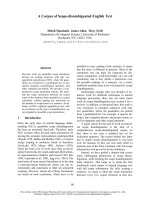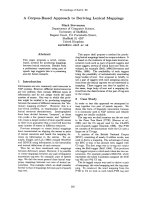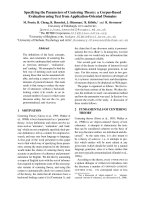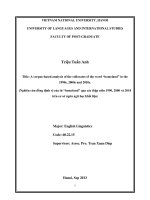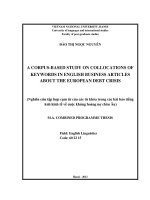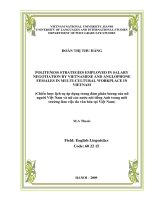If condtional structures expressing politeness strategies a corpus based research on english and american press discourse (tt)
Bạn đang xem bản rút gọn của tài liệu. Xem và tải ngay bản đầy đủ của tài liệu tại đây (1.04 MB, 34 trang )
THE UNIVERSITY OF DANANG
UNIVERSITY OF FOREIGN LANGUAGE STUDIES
VÕ THỊ THANH TRÚC
IF CONDITIONAL STRUCTURES
EXPRESSING POLITENESS STRATEGIES:
A CORPUS-BASED RESEARCH ON ENGLISH
AND AMERICAN PRESS DISCOURSE
Major
Code
: English Linguistics
: 822.02.01
MASTER THESIS IN FOREIGN LANGUAGES,
LITERATURE AND CULTURE
(SUMMARY)
Danang - 2018
The thesis has been completed at
University of Foreign Language Studies, The University of Da Nang
Supervisor: Assoc. Prof. TRAN HUU PHUC, PhD
Examiner 1: Assoc. Prof. Lam Quang Dong, PhD
Examiner 2: Bao Kham, PhD
The thesis will be orally defended at The Examining Committee
Time : 27th October 2018
Venue: University of Foreign Language Studies
- The University of Da Nang
The thesis is accessible for the purpose of reference at:
- The Information Resource Center, The University of Danang
- The Library of University of Foreign Language Studies,
The University of Danang
1
Chapter One
INTRODUCTION
1.1. RATIONALE
One of the key elements to communicate successfully with
other people is being polite. Moreover, being polite in every business
communication is very essential to create the effective of cooperative
process, especially in intercultural contexts nowadays. A lot of
research on modality, if conditionals, politeness strategies and
corpus-based analysis has been carried out; however, none of these
research works seem to be conducted on modality in terms of
pragmatics, as well as modality in if conditional structures in
language. Therefore, If Conditional Structures in correlation between
English and American Press discourse should be thoroughly
considered.
1.2. AIMS AND OBJECTIVES
1.2.1. Aims
The study aims at investigating If Conditional Structures
expressing politeness through corpus-based approach. The study is
also aimed at finding the differences and similarities in the language
of expressing politeness between English and American Press in
terms of politeness strategies. The study’s findings are expected to
contribute to the better understanding of politeness expressions, how
to save theirs and other party’s face and to use these strategies in
communication effectively by writing politely.
1.2.2. Objectives
To achieve the aims of the study, the thesis is intended to:
- Analyze politeness strategies employed in If Conditional
Structures;
2
-
Compare the similarities and differences of English and
-
American Press in terms of politeness strategies expressed by
If Conditional Structures;
Propose several implications of findings for the teaching and
learning of if conditional structure English involving in
politeness strategies.
1.3. RESEARCH QUESTIONS
Based on the research objectives, this research is formulated in
the following questions:
1. What politeness strategies are identified from If conditionals
in the English Press Discourse?
2. What politeness strategies are identified from If conditionals
in the American Press Discourse?
3. What are similarities and differences of politeness strategies
identified from If Conditionals between English and
American Press Discourse?
1.4. SCOPE OF THE STUDY
The study primarily focuses on the analysis of English and
American Press. Particularly, the researcher examines the language in
terms of politeness strategies used.
1.5. SIGNIFICANCE OF THE STUDY
1.6. ORGANIZATION OF THE STUDY
Chapter Two
LITERATURE REVIEW AND THEORETICAL
BACKGROUND
2.1. LITERATURE REVIEW
Regarding research in Politeness strategies, so far an
adequate number of studies have been carried out. Boncea (2013)
3
carried out a research on Hedging of Patterns used as Politeness
strategies and found that If Conditional are the preferred option in
rendering hypothetical meaning with actions which are deemed
possible only if certain conditions are met. The reason why they play
an important role as hedges is that speakers can use if clauses to
invoke potential barriers in the way of their future or past actions
which could help them disclaim responsibility for the absoluteness of
their statements.
Hasselg˚ard (2014) studied the Conditionals with respect to
their form, meaning and placement. Through a cross-linguistic
comparison of original texts between English and Norwegian, the
linguist uncovers much similarity between the languages as regards
properties of conditionals, but certain frequency differences as
regards syntactic and semantic choices.
In addition, number of research projects has been focused on
aspects of pragmatics of If Conditional through comparative between
English and Vietnamese. For instance, Vo Thi Kim Anh (2010)
focused on pragmatic function of if Conditional Structures
concerning illocutionary act in English and Vietnamese: threatening,
advising, warning, criticizing, offering, requesting, regretting, and
softening.
Tran Thi Ngoc Du (2012) examined the linguistic features of
conditional speech acts in English and Vietnamese and the
similarities and differences of these linguistic units in terms of syntax
and pragmatics.
In conclusion to this section, all of these above studies have been
explored several aspects of politeness in English and Vietnamese.
However, it seems that a few have been done to study the contrastive
analysis of politeness strategies in If Conditional Structures between
4
English and American Press. Therefore, it is expected that the study
is an effort to bridge this gap, contributing to help Vietnamese
learners of English to better understand the differences and
similarities of politeness strategies of each language.
2.2. MODALITY
2.2.1. Modality in language study
According to Huddleston & Pullum (2002:173), Modality is
“concerned with the speaker’s attitude towards the factuality or
actualisation of the situation expressed by the rest of the clause”.
2.2.3. Categories of modality
According to Palmer (1986), he analyzed modality with three
basic categories of epistemic, deontic and dynamic (as presented in
the figure 2.2)
Epistemic
Deontic
Dynamic
Figure 2.2. Types of modality, according to Palmer (1986)
2.3. IF CONDITIONAL STRUCTURES
2.3.2. Hypothetical, course of event and marginal condtions
Athanasiadou & Dirven (1996:611) introduced 2 types of
conditions: event-based condition and margin. A new point in this
classification is Athanasiadou & Dirven (1996) analyzed into
subcategories (as in Figure 2.5) and time reference is considered as
main criteria of Athanasiadou & Dirven (1996). Athanasiadou &
5
Dirven (1996:611) divided event-based conditionals into two
subcategories: course of events and hypothetical conditionals;
marginal consist of two subcategories: logical and conversational.
conditonals
envent based
course of event
hypothesis
marginal
logical
conversational
Figure 2.5.: Types of condition according to Athanasiadou & Dirven
(1996)
2.4. POLITENESS
2.4.3. Factors influencing the choise of politeness strategies
Brown and Levinson then focus especially on acts
threatening the addressee, providing us with a taxonomy of strategies
that the speaker can follow when intending to do the FTA. In Brown
and Levinson’s Politeness Strategies, the perspective of “face” is
central of their theory. A set of five strategies to minimize risk of
losing face is suggested by these two authors. The choice of the
strategies will be made on the basic of the speaker’s assessment of
the size of the face threatening acts, which are certain illocutionary
acts liable to damage of threaten another person’s face. This can also
be illustrated in the following figure:
6
Figure 2.6: Strategies for performing FTAs (Brown & Levinson,
1987:60)
Chapter Three
RESEARCH METHODS
3.1. METHODOLOGY
3.2. RESEARCH DESIGN
3.2.1. Data collection
Table 3.3: Two corpora used for research
Name
GuardianBusiness
Section
New
York
Times –
Business
Section
Total
Code
No of
articles
No of
words
Average
number of
words/article
Number
of If
structures
Time
GDC
334
153906
460.7
680
2011
NYTC
124
121224
977.6
371
2011
458
275130
1438.3
1051
7
3.2.2. Data analysis
Based on 458 articles of two corpuses are collected, the
expressions of If Conditional Structures English and American Press
were analyzed in terms of these following aspects:
Politeness strategies employed in If Conditional Structures
in English and American Press
Frequency in use of If conditional Structures in English and
American Press in the view of Politeness Theory.
In order to support language analysis, there are various software
utilities that are used to provide data for analyzing a specific problem
of the language through a method of analyzing the data. This study
uses
WordSmith
5.0
(copyrighted)
( />
Figure 3.1: Wordsmith 5.0
8
The data provided for the analysis of the condition if structure
expressing polite strategy in the English discourse is based primarily
on basic tools such as: key words, word lists, the frequency list and
the concordance lines, the collocation of the software. Collected data
is converted into electronic text (plain text format) in accordance
with WordSmith 5.0 software to provide data for analysis of if
conditional structure.
Figure3.2.: If structure from New York Times Corpus
Figure3.3.: If Structure of Guardian corpus
9
3.3. RELIABILITY AND VALIDITY
3.4. SUMMARY
Chapter four
FINDING AND DISCUSSION
4.1.
IF
CONDITIONAL
STRUCTURES
SHOWING
POLITENESS STRATEGIES
From the data collected from New York Times and Guardian
Corpus, the total if structures come up to 1051. However, the number
of structures expressing politeness strategies is not account for a large
proportion as I expected. The percentage of If conditionals
expressing politeness strategies from two corpora are displayed as in
the following chart:
Table 4.1.: If conditional structures collected form from New York
Times Corpus and Guardian Corpus
If
conditional
structures
NYTC
Number
Frequency
(%)
GDC
Number
Frequency
(%)
expressing
politeness
strategies
235
64%
348
51.1%
without
politeness
strategies
136
36%
333
48.9%
371
100%
680
100%
Total
10
if structures
expressing politeness
36%
64%
If structures
without politeness
strategies
Figure 4.1.: If conditional structures collected form from New York
Times Corpus
if structures
expressing politeness
51.1%
48.9%
If structures
without politeness
strategies
Figure 4.2.: If conditional structures collected form from Guardian
Corpus
From the chart above, we can see that If conditional
structures expressing politeness make up more than a half in
frequency of if structures in both New York Times and Guardian
corpora (64% and 51.1% respectively). The number also proved that
the writers used politeness strategies embedded in If structures and
they occur intentionally with various patterns.
11
4.2. CUTURAL DIFFRENCES BETWEEN ENGLISH AND
AMERICAN PEOPLE
It is the fact that English and American people have an
enormous amount in common in terms of history, values, popular
culture and language. However, there are still subtle differences
between the two cultures and paying attention to these nuances will
help people are more comfortable when working with them.
A lot of discussion has been made to find out whether any
evidence for these distinction. And one of these differences can be
seen clearly is the distinction of culture and language involved.
According to Bryant (2017), the difference is observed at workplace
by the way worker from these two countries communicate to their
colleagues:
“Because the British prefer understatement and generally dislike
confrontation, they may be viewed by American colleagues as
passive-aggressive,
for
example,
using
sarcasm
in
correspondence rather than facing the issue. Situations like this
need to be addressed with sensitivity by both parties.”
Another evidence for the difference is that “Americans are
much more direct communicators” (Bryant, 2017).
She also convinced that:
“The British employ more complex communication techniques,
often saying the opposite of what they really mean, sometimes in
jest. “That’s quite a good idea”, for example, generally means the
person thinks it’s a terrible idea. British people will use humor to
diffuse an awkward situation, which Americans can find confusing.
Having said that, Americans can also give mixed messages; ‘Let’s
do lunch’ generally means somebody is not overly keen on seeing
you again.”
12
According to Bezroukoy (2017), in his online article named
“Negative politeness”, stated that in Great Britain, negative
politeness, which means showing respect, are used quite often than
positive politeness, which showing solidarity, claiming common
ground, demonstrating “we are in the same team” attitude.
It is obvious that between the two countries, there are still
some differences in language and culture should be examined. And
culture could be considered one of the important factor affect to the
politeness using in spoken communication in general as well as in
writing communication in particular and in this case, Business
articles from two corpora collected are selected to light up the
features.
Based on the finding of the research, positive politeness and
negative politeness in two corpora are presented as in table and figure
below:
Table 4.2.: Number of Politeness strategies used in NYTC and GDC
Politeness strategies
NYTC
GDC
Negative
180
204
Positive
55
144
Total
235
348
13
250
200
150
Negative
100
Positive
50
0
NYTC
GDC
Figure 4.3.: Negative and positive politeness presented from two
corpora
4.3. NEGATIVE POLITENESS STRATEGIES
In business articles, the hearers/ readers are wide range of
people, therefore the writers are assumed to write politely. From the
findings of the study, negative politeness strategies are found in New
York Times and Guardian Newspaper listed as the following four
subcategories: using indirectness; question, hedging; being
pessimistic and pluralizing on the “you” and “I”.
Table 4.3.: Frequency of Negative Politeness Strategies used in NYT
Corpus and Guardian Corpus
Negative politeness
strategies
If structures
NYTC GDC
Frequency %
NYTC
GDC
1
Using indirectness
21
13
11,7
6,4
2
Question, hedging
49
63
27,2
30,9
3
Being pessimistic
96
104
53,3
51,0
4
Pluralizing pronoun
14
24
7,8
11,8
180
204
100%
100%
Total
4.3.1. Using Indirectness
One of the four strategies I would like to mention first is
using indirectness. Based on the data of two corpora, some If
14
conditional patterns are used to cover this negative politeness
strategy. If conditionals are accompanied with the semi-modal verbs
“seem” and “appear” to help speakers/ writers not only achieve their
goal in communication by the utterance but also show their wish to
reduce the imposition, present their awkwardness and embarrassed
when giving an utterance.
Table 4.4.: Frequency of If Structure patterns used in using
indirectness
Strategy
Using
directness
Pattern
NYTC
GDC
If + S + auxiliary + not…,
S + appear/ seem…
1
2
If not …, S + would/
could/ appear…
6
3
If possible,…
1
0
If necessary
1
2
If + S + could
12
6
21
13
Total
4.3.2. Question, hedging on the force of an FTA
As observed form the samples of NYTC and GDC, there are
some situations that the speakers/ writer addresses sensitive issues
and they must rely on negative politeness strategies to “save face” for
the hearers/ readers. The negative politeness strategy implemented to
avoid violating hearers “face” in such cases is hedging on the force of
an FTA by using if conditional patterns. The structures: “If you want
to…” or “If you want to invest …,” are mainly used to convey the
messages of the speakers that the action has just been done only in a
certain condition to minimize the imposition on the hearers.
15
Table 4.5.: Frequency of If Structure patterns used in question,
hedging strategy
Strategy
Pattern
NYTC
GDC
Question,
hedging
If you want to…, S +
have/has to
1
2
If you have to …, S +
might /could…
1
1
If it…
30
57
If there
7
13
What if
10
0
49
63
Total
4.3.3. Be pessimistic
Turning to another strategy of negative politeness strategies,
being pessimistic should be thoroughly considered. According to
Nguyen Quang (2004), be pessimistic can be examined via three sub
strategies including: using assumption, using some pessimistic
hedges and negation.
Table 4.6.: Frequency of If Structure patterns used in being
pessimistic strategy
Strategy
Being
pessimistic
Pattern
If you + modal… , V …
If you are, S would/ could/ might
If + clause, S + might
If S were…, S + /will/be going to
If S were.., S would/could/might
If so
If only
If that…
NYTC
1
2
8
3
21
0
0
7
GDC
4
3
4
2
19
15
9
17
16
Strategy
Total
Pattern
NYTC
If S were/ were not…, S would/
24
could/may
If you don’t …, S + may/ can/
7
could…
If S + auxiliary + not…, S + may
21
/ can/ could…
If + S + auxiliary + not, S + will/
2
will not
96
GDC
21
2
3
5
104
4.3.4. Pluralization of the “you” and “I” pronoun
Finally, observation from NYTC and GDC, pluralization of
the “you” and”I” pronoun is also employed in NYT and GD articles.
Brown & Levinson (1987: 203) stated that: “but such an inclusive
“we” in other contexts may become the conventionalized polite form
appropriate to formal situations and negative politeness.” If
conditional patterns of tentativeness combine with plural pronoun
“we” seem to be more polite.
Table 4.7.: Frequency of If Structure patterns used in
pluralizing pronoun
Strategy
Pattern
NYTC
GDC
Pluralization pronoun If we…
inclusive “we”
If .., we
10
17
4
7
Total
14
24
4.4. POSIVETIVE POLITENESS STRATEGIES
Brown and Levinson (1987: 103-129) proposed the “three
broad mechanisms” of positive politeness: (1) “claim common
17
ground”, (2) “convey that S and H are cooperators” and (3) “fulfil
H’s want for some X” which are actually indicators of the speaker’s
solidarity with hearers. Tran Huu Phuc (2016: 62) proposed five
strategies and in this thesis I employ and add some additional
patterns. Examined from NYTC and GDC corpora, If conditional
expressing politeness strategies are listed into five strategies: paying
attention, expressing strong commitment, giving advice, showing
intimateness and encouraging.
Table 4.8: Frequency of Positive Politeness Strategies used in NYT
Corpus and Guardian Corpus
Positive Politeness Strategies
If Structures
Frequency
NYTC
GDC
NYTC
GDC
1
Paying attention
13
9
24.1%
6.3%
2
Expressing strong commitment
18
103
33.3%
71.5%
3
Giving advice
2
13
3.7%
9%
4
Showing intimateness
3
1
5.6%
0.7%
5
Encouraging
18
18
33.3%
12.5%
54
144
100%
100%
Total
4.4.1. Paying attention to hearers
To be polite in communication, the speaker not only shows
caring to the information produced but also the language expression.
Paying attention to hearers’ needs or addressing hearers’ desires
without violating their face wants is one of positive politeness
strategies would be examined. In this strategy, speakers imply that
they share the hearers’ point of views, approve of hearers’ desires
and would like to establish a common ground with hearers. Speaker
wishes to notice the hearers’ interest, need and goods.
18
Table 4.9.: Frequency of If Structure patterns used in paying attention
to hearer
Strategy
Paying
attention to
hearer
Pattern
NYTC
GDC
If you want
3
3
If you need
2
0
If you believe
0
2
If you like
6
1
If you intend to
0
1
If you prefer
0
1
If you think
2
1
13
9
Total
4.4.2. Expressing strong commitment
Another strategy used in positive politeness is expressing
strong commitment to hearer. From the examined data in NYTC and
GDC, If conditional structures are accompanied with some phrases
such as: “what we already know”… to claim that both speaker/writer
and hearer/ reader are in common ground, are known about the issues
discussed and may interest in the concerning problem. And speaker
can give hearer commitment for what he already know or ensure.
Table 4.10.: Frequency of If Structure patterns used in
expressing strong commitment
Strategy
Pattern
NYTC
GDC
Asserting
common
If S…, S will
4
28
If S …, S could
6
9
ground
If S …, S would
8
61
Only if
0
5
If you are…, you can/ may/ will
16
9
18
103
Total
19
4.4.3. Giving advice
Turning to giving advice strategy, this one shows the speaker
knows what the hearer’s wants and is willing to care about that
desire. Advice “S should”, “ S had better” with the conditional clause
“If S + auxiliary + not” were a common way of saying “is used as a
low level commitment to what is said” (House & Kasper, 1981: 167),
as in the following examples:
(50) If expenses, and not return, were the primary concern, Ms.
Brown said an investor should simply invest in an index fund and
forget about it. [NYT97]
(51) Of course, they are absolutely right, but if we are not prepared
to sacrifice these things in order to preserve our high streets – and I
suspect we're not – then we should stop complaining and let the big
retailers get on with it. [GD333]
Table 4.11.: Frequency of If Structure patterns used in giving advice
Strategy
Giving
advice
Total
Pattern
NYTC
GDC
If S + were …, S should
1
5
If S + were, S suggested
1
0
If S + auxiliary not…, S should
0
7
If S want…, S had better
0
1
2
13
The If conditional clause “if S were… S should/ had
better…” to show the interest of the speaker in the face of the
listener. It is the fact that the speaker wants to send the message to
the hearer/ reader that he is not completely committed to what is
being said, but that it is just his desire as a sharing with the reader. So
this is a positive strategy for avoiding a person's positive side impact
(see Brown and Levinson, 1987).
20
4.4.4. Showing intimateness
Via analyzing the data, showing intimateness is also pointed
out to show politeness strategies. If conditionals are combined with
phrases “don’t forget” or “remember” in the main clause to display
the reminder of speaker/writer. With this model, the speaker
establishes the condition and exposes the desire for the listener to
perform the action, as shown in the examples below:
(54) Investors in BP are obsessed by how their company plans to
close the perceived "discount" between today's share price and the
price at which the stock might trade if Macondo had never
happened (the shares were 650p beforehand, don't forget). [GD1]
(55) And remember, P.&G. could have negotiated in the agreement
for a termination right if Diamond’s stock price fell by this
amount.[NYT112]
(56) “But if companies cut, forget dividends — that’s a sign that the
economy is really shot,” he said. [NYT124]
Table 4.12.: Frequency of If Structure patterns used in showing
intimateness
Strategy
Showing
intimateness
Pattern
NYTC
GDC
If …, don’t forget…
0
1
If…, remember
1
0
If…, forget
2
0
3
1
Total
The use of “do not forget” or “remember…” structures shows
that the speaker and the receiver have a certain intimacy. The
expression “do not forget …” is considered a positive politeness
strategy because it shows the speaker expressing interest and being
close to the receiver. In this case, we only show reminders not to
21
forget something or do an action when we are really close and
intimate with communication partners.
4.4.5. Encouraging
According to Brown & Levinson (1987), Positive politeness
has been characterized as the politeness of solidarity by showing the
speaker’s agreement, co-operation and attendance to hearers. An
interesting fact is revealed to the desire of the hearer that is the
expressing encouragement. In samples of If conditional patterns such
as “if you can…” and followed by action verbs are frequently used to
express the speaker’s encouragement and consultancy for hearers to
perform an action as they are suggested to do. These If conditionals
are combined with explicit and direct statements to indicate the
speakers’ co-operative behavior and are thus categorized as If
structures of positive politeness as in the following examples:
(57) “If we can prove wrong those who are betting on Greece to fail,
we will see the crisis recede,” he said. [NYT82]
(58) Nice work if you can get it. [GD29]
(59) Banks can work if they do the splits. [GD199]
Table 4.13: Frequency of If Structure patterns used in Encouraging
Strategy
Encouraging
Pattern
NYTC
GDC
If S + can …,
3
12
If S…, S can
15
6
Total
18
18
4.5. THE DIFFERENCES BETWEEN ENGLISH AND
AMERICAN PRESS
4.5.1. Differences in frequency of If structures in negative
politeness of NYTC and GDC
22
7.8% 11.7%
Using indirectness
Question, hedging
27.2%
Being pessimistic
Pluralizing pronoun
53.3%
Figure 4.4.: Negative politeness strategies used in GDC
11.8%
6.4%
Using indirectness
30.9%
51%
Question, hedging
Being pessimistic
Pluralizing pronoun
Figure 4.5.: Negative politeness strategies used in NYTC
The two figures show negative politeness strategies used in
GDC and NYT in Business section in 2011. Through the two figures
(4.4 versus 4.5) we can see clearly that there are some differences in
frequency of negative politeness used in NYTC and GDC. Generally,
there are the differences in percentage between negative politeness
strategies used in the two corpus. To begin with question and hedging
strategy, it accounts for 30.9% in NYTC and higher than the number
measured from GDC (27.2%). In which, patterns with dummy
subjects “if it” and “if there” are employed with higher frequency. As
23
for expressing being pessimistic strategies, it is observed that the
frequency occurrence of If structure patterns in NYTC are
approximately equal to figure GDC (51% and 50.3% respectively).
Both articles form NYTC and GDC seem to be more reserved in
politeness when they take a lot of hypothetical conditionals,
pessimistic hedges and negation structures into account before stating
about the prediction or core content of the problem. Take a look at
using indirectness, If structure patterns denoted politeness strategies
appear with nearly double frequency, in which GDC amounts to
11.7%, it is larger than NYTC with only 6.4%.
Most noticeably of all, it can be seen that pluralizing pronoun in
NYTC are larger in comparison with the number collected from GDC
(11.8% and 7.8% respectively).
All If structure patterns collected from the data are categorized and
presented in the following table.
Table 4.14: Frequency of If Structures used in Negative
politeness strategies of NYTC and GDC
Strategy
Using
directness
Question,
hedging
Being
pessimistic
Pattern
If + S + auxiliary + not…, S + appear/ seem…
If not …, S + would/ could/ appear…
If possible,…
If necessary
If + S + could
If you want to…, S + have/has to
If you have to …, S + might /could…
If it…
If there
What if
If you + modal… , V …
If you are, S would/ could/ might
NYTC
1
6
1
1
12
1
1
30
7
10
1
2
GDC
2
3
0
2
6
2
1
57
13
0
4
3

